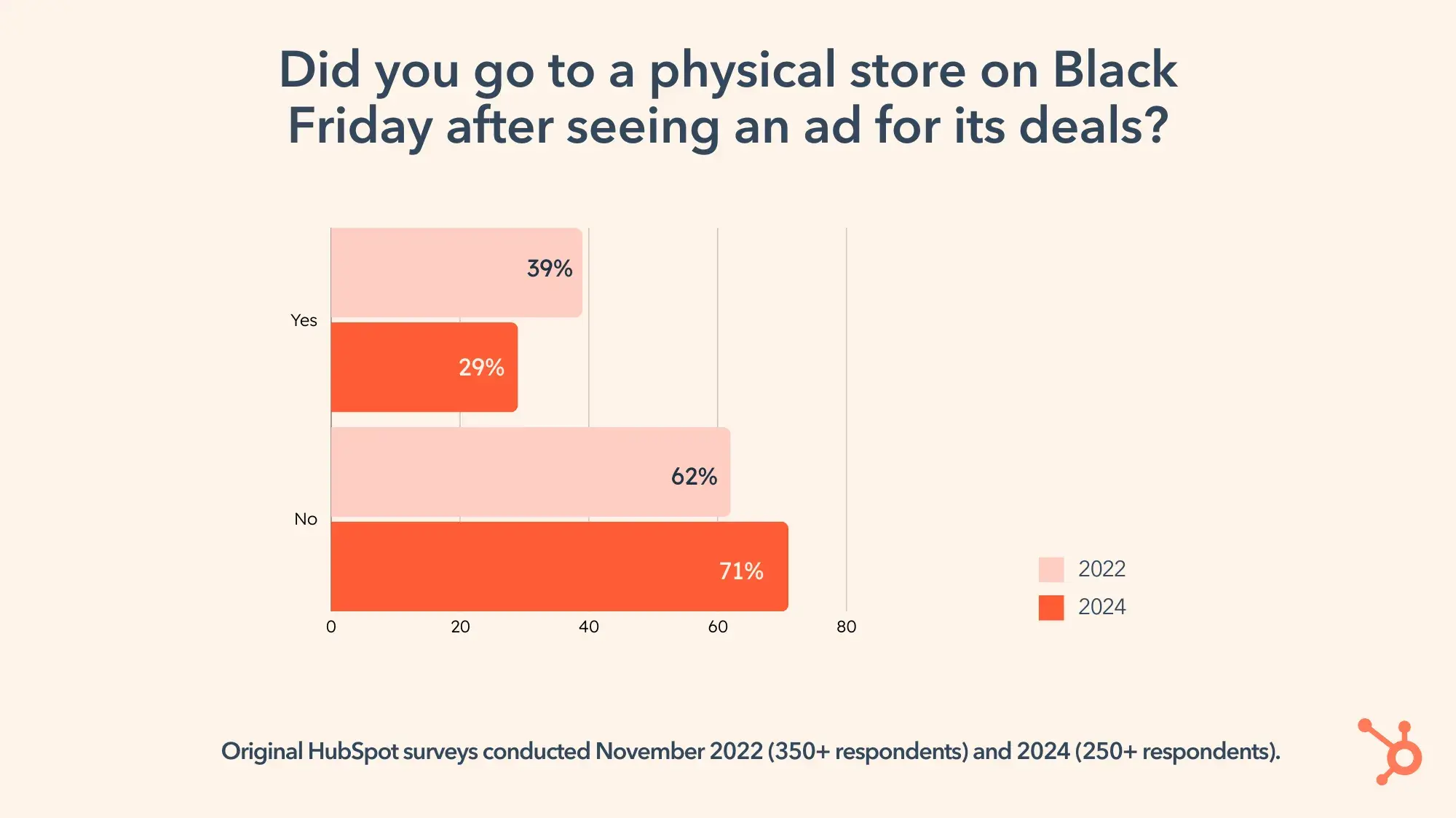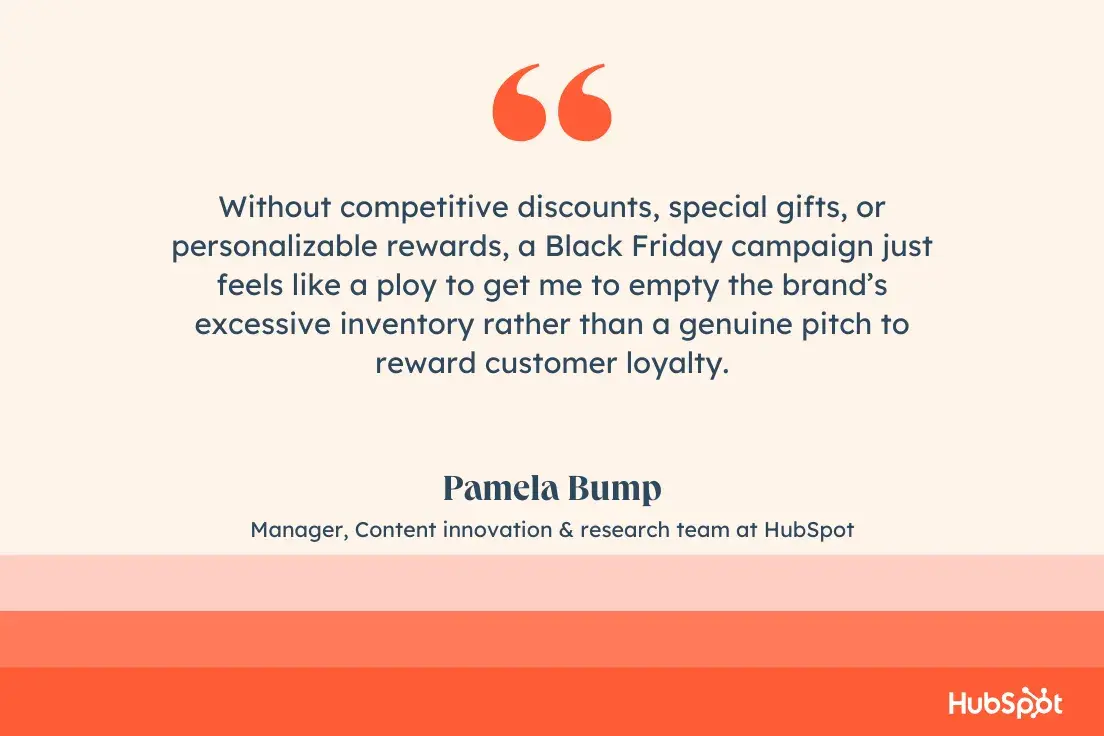I’m much more the “spend Black Friday at home in my pajamas” type, but I have a few family members who for some reason enjoy getting up at 4 a.m. to wait in lines for doorbuster deals.

Online or in-store, consumer or marketer, Black Friday and Cyber Monday are formidable forces.
HubSpot polled 250+ people to discover how shoppers and brands fared on Black Friday 2024. We last ran this survey in 2022, so we’ll take a look at how things have changed in the last two years.
(One note on our data: Our 2022 poll had 325 respondents, and our 2024 poll had 250 respondents.)
I’ve also got some marketing tips on creating Black Friday ads and some examples to get you thinking creatively about next year’s campaign.
Table of Contents
What We Learned About Black Friday Shoppers & Brands in 2024
You already know that the five days between Thanksgiving and Cyber Monday are some of the biggest shopping days of the year, but let me set the scene with a few quick stats:
- $235: The average amount spent specifically on holiday gifts during Thanksgiving weekend (National Retail Federation)
- $925: The average amount that Americans are planning to spend during the 2024 holiday season (NerdWallet)
- 197 million: How many U.S. shoppers made purchases between Thanksgiving and Cyber Monday 2024 (National Retail Federation)
- $13.3 billion: How many dollars U.S. consumers spent on Cyber Monday 2024 (Adobe Analytics)
- 1950%: The increase in traffic to online retail websites from 2023 to 2024 (Adobe Analytics)
Here’s what we learned from our survey about Black Friday 2024:
1. The “Browse But Don’t Buy” effect has increased.
Virtual window shoppers are on the rise. According to our research, there’s an equal split (34% each) between people who purchase something after clicking an ad and those who click but don’t buy. That’s up from 2022 (27%), suggesting that consumers are evaluating deals more carefully.
We’re also seeing more passive deal-hunters this year, which might suggest that shoppers are more opportunistic and less strategic than in past years.

2. Digital advertising dominates — but don’t abandon SOCIAL MEDIA.
We asked where respondents saw the Black Friday ads that they clicked on.
In 2022, SOCIAL MEDIA (32%) and online ads (33%) were nearly equally effective at earning clicks. Our research shows a widening gap in 2024, with online ads pulling ahead.

There’s a few possible reasons we saw this increase in our research.
Consumers may be more responsive to online ads; AI tools may be driving better personalization and segmentation, so consumers could be getting more relevant ads; it could be a combination of factors.
A 2024 Statista report that measured awareness of Black Friday and Cyber Monday (as opposed to evaluating clicks, as our study did) suggests that SOCIAL MEDIA and online advertising are equally effective channels.
That study also showed some differences in age demographic, with 18- to 34-year-olds more engaged on both channels as opposed to 35+.
SOCIAL MEDIA remains an important marketing channel, and it’s certainly not going anywhere — U.S. marketers put a total of $72.3 billion into SOCIAL MEDIA ads in 2023 — but it’s a good time to take a closer look at your playbook.
4. Store traffic has declined.
Our survey saw a dip in visits to brick-and-mortar stores, with 29% of respondents in 2024 saying that they visited a store as a result of a Black Friday ad, compared to 39% in 2022.

To be fair, it was cold over Thanksgiving weekend in 2024 (70% of people in the lower 48 got what the New York Times describes as “freezing cold” and what I describe as “miserable”).
But when you can get doorbuster deals without taking your house slippers off, retailers are offering fewer reasons to face Black Friday traffic and more reasons to shop from home.
5. Email marketing remains a challenge.
Have marketing emails hit their saturation point? My inbox, at least, says yes.
Although the number of people who responded positively to marketing emails hasn’t changed much (11% in 2022 and 10% in 2024), the consistently low percentage is noteworthy given just how many Black Friday email campaigns there are.
I searched my personal email for “Black Friday,” and I could practically hear Gmail groan under the weight of my request. The following emails all arrived within a two-hour window 48 hours after Black Friday ostensibly ended:

When you build your BFCM email marketing strategy, remember that every single one of your customers will have an inbox that looks very similar to mine. What will make your target audience click?
4 Tips for Creating Effective Black Friday Ads
1. Focus on online ad placement.
Our research showed an uptick in receptiveness to online ads versus ads on SOCIAL MEDIA. AI tools can help you effectively segment and target your audience for a more sophisticated take on traditional online ad placements.
We also asked respondents an open-ended question about their overall impression of Black Friday ads, and then used sentiment analysis to determine how positive or negative their impressions were.
There’s a slight increase in neutral impressions from 2022, but overall, consumers are still solidly positive. That’s good news for marketers, whether you focus your digital efforts on SOCIAL MEDIA, elsewhere, or both.

2. Address virtual window shoppers and passive deal-seekers.
Shoppers are less decisive and less proactive when it comes to those sweet sweet BFCM deals. When creating a Cyber Week marketing strategy, consider how you’ll close deals and attract new customers.
Although a substantial number of shoppers still actively seek out online Black Friday deals (46% in 2022 and 44% in 2024), a growing number are letting the deals come to them.

Twenty-four percent of our respondents in 2024, compared to 17% in 2022, said that they waited for Black Friday deals but didn’t research them beforehand.
That puts the burden of proof on marketers to get their campaigns in front of the right people — and those deals better be good if you want consumers to click.
3. De-emphasize in-store components.
Can you offer the same doorbuster-type deals online as you can in a brick-and-mortar store, and maybe throw in free shipping?
Unsurprising to anybody who knows the joy of spending Black Friday in their loosest sweatpants, we’re seeing more consumers shopping from home.
When asked if they went to a physical store after seeing a Black Friday ad, nearly three-quarters of our 2024 respondents said “nope.” Two years prior, that number was 62%.
4. Use positive, practical messaging that focuses on the customer, not the brand.
I asked a Slack channel full of content marketers what made for a losing Black Friday ad.
Pamela Bump, manager of HubSpot’s content innovation and research team, said that she saw a few brands whose “deals” weren’t really about the customer at all.
“We’re seeing the same TikToks we saw last year from big-box stores with thousands of unbought TVs. Customers are noting that the product stickers said 30% off — but the price isn’t that different from a few days before.”
Bump says, “Without competitive discounts, special gifts, or personalizable rewards, a Black Friday campaign just feels like a ploy to get me to empty the brand’s excessive inventory rather than a genuine pitch to reward customer loyalty.”

Black Friday Campaign Ideas
1. Anti-Black Friday Campaigns
The Green Friday movement began in 2015 as an environmentally friendly alternative to rampant consumerism.
That’s also the year that outdoor gear giant REI introduced its #OptOutside campaign, in which the retailer closes its real and virtual doors, postponing any online orders so its employees can enjoy a paid day off.
REI

More than purpose-driven marketing or brand awareness, REI is living its core values. Even the most hardened cynic would be hard-pressed to ignore the simple goodness at the core of REI’s message: Our employees are more important than Black Friday sales.
Plus, REI still offers BFCM sales and discounts — just a few days later.
Cards Against Humanity
Environmental awareness isn’t the only way to craft an anti-Black Friday campaign.
Back in 2015, I participated in CAH’s most infamous Black Friday stunt, which was either delightful or infuriating, depending on your sense of humor. The deal was this: Send them $5. You’d get nothing in return.
The company did exactly what it promised. Twelve-thousand three-hundred sixty-seven people, including yours truly, sent at least $5 to CAH, which split the cash among its 17 employees.
What did they do with the $4,185 each CAH employee earned overnight? I’m so glad you asked.
One person bought 760 pounds of cat litter; another blew $1,500 on a custom suit of men’s armor. All 17 employees listed how they spent their windfall on CAH’s website, calling the bluff of anybody who doubted in their unusual campaign.
I can’t recommend taking this approach with your own Black Friday campaigns, but sometimes a huge gamble pays off. CAH’s Black Friday games and pranks have become a tradition of sorts, with fans looking forward to the next year’s creative endeavor. There’s even a subreddit.
2. Upgrades, Bonuses, Freebies, and Novelties
Many online retailers offer freebies and bonuses like free shipping, extra points, free personalization, and other little luxuries.
Barnes & Noble
Barnes & Noble runs a special Black Friday deal on signed books — available online or in-store — that includes exclusive special editions.

Leuchtturm1917
I’m obsessed with my Leuchtturm notebooks, and usually have two or three going at any given time. I like to splurge and get them personalized with my initials, which costs me an extra $10. So seeing the words “free personalization” in an email subject line catches my attention every Black Friday.

I’ve also seen retailers offer free shipping on all orders, free expedited shipping, an extended return period, and other little luxuries that make customers feel appreciated.
3. Giving Back
Everlane
Online clothier Everlane began its Black Friday Fund in 2014, and each year it chooses a different non-profit partner. This year, it made a $50k donation toward regenerative agriculture.

National Park Service
Retailers aren’t the only ones leveraging Black Friday deals. The National Park Service runs a very clever #GreenFriday campaign to get Americans off our La-Z-Boys and into the wilderness.
Modeled after traditional BFCM deals lists, NPS’ list includes “Deals for Phones” that promote its free NPS app to help you plan your visit.
And if you’re not near a national park (or just prefer your La-Z-Boy; no judgment), NPS offers a great deal on streaming bundles: a list of the 200+ webcams at parks around the country.

4. Real Deals
At the end of the day, shoppers like Black Friday because they want to save money. So if you’re offering real deals on items that your customers want, you’re already a step ahead.
Dyson
Dyson, the maker of heartbreakingly expensive vacuum cleaners, ran a BFCM deal of $270 off its $500 slim model. That’s 54% off, and it puts the vacuum within reach of a lot more customers.

Think big when it comes to discounts — it centers the customer experience, and the payoff might be an increase in new customers who otherwise couldn’t or wouldn’t splurge on your product or service.
Lessons in BFCM Marketing
Every Black Friday campaign is an opportunity to learn about your customers and target audience. Put them first — whether that’s with a traditional BFCM discount, doubling up on loyalty perks, or by giving back to your community.
Editor’s note: This post was originally published in December 2016 and has been updated for comprehensiveness.
https://blog.hubspot.com/marketing/black-friday-ads

![Download Now: The State of U.S. Consumer Trends [Free Report]](https://no-cache.hubspot.com/cta/default/53/ebf9ec8e-a468-455a-943e-80aa4e6be694.png)


